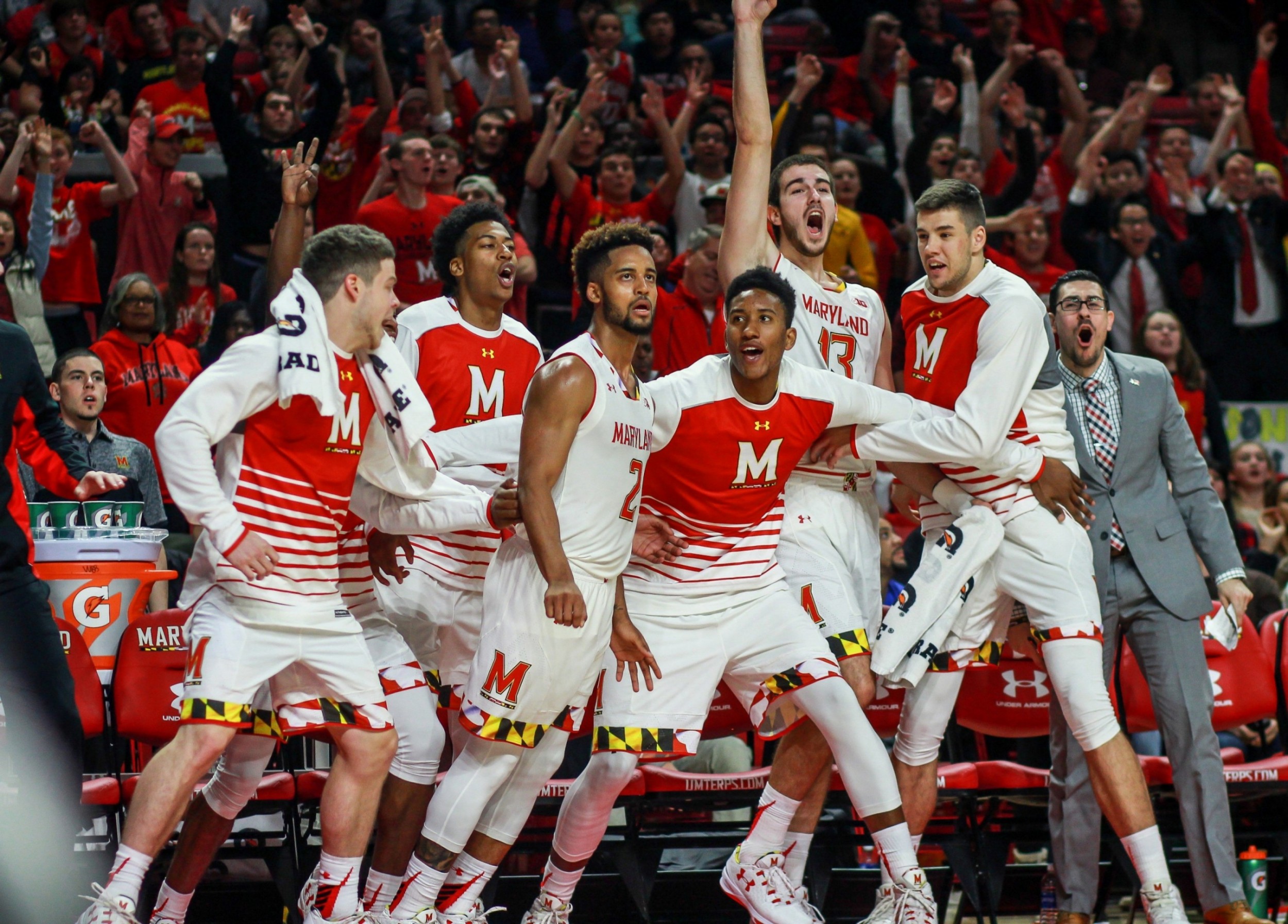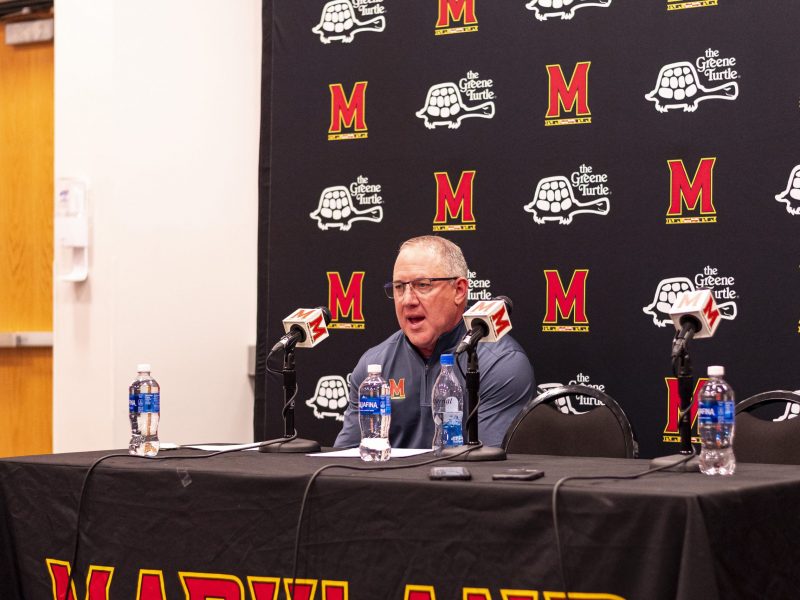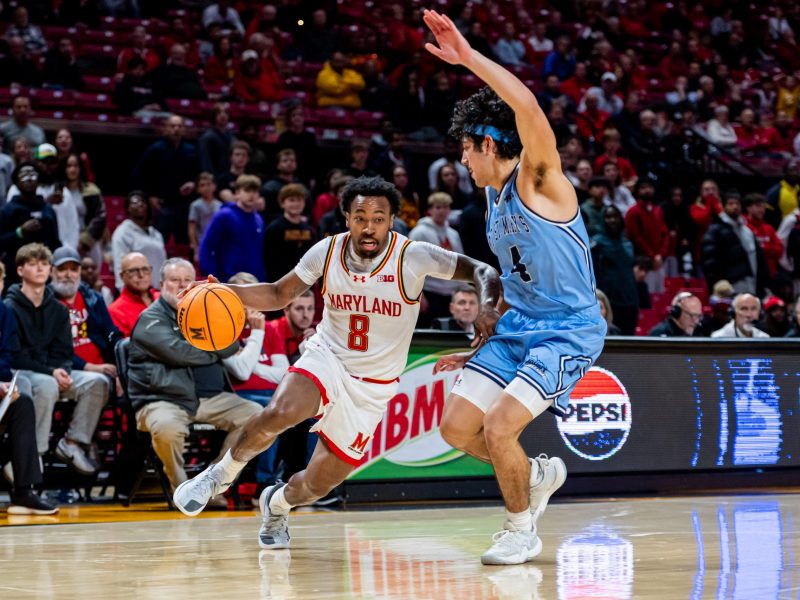The Maryland men’s basketball team has exceeded most critics’ expectations this season. The Terps (18-2, 6-1 Big Ten) sit at the top of the Big Ten standings, and they just matched their best start through 20 games since the 1998-99 rankings.
Guard Melo Trimble, who averages the sixth-most points per game in the conference (17.4), leads the Terps while playing off the ball for the majority of contests. One of three freshmen starters, guard Anthony Cowan has taken over as the team’s facilitator, averaging 10.9 points and 3.6 assists per game.
Forward Justin Jackson and Kevin Huerter are the other freshmen starters and have been consistent while Maryland’s frontcourt has battled injuries and foul trouble. The Terps have won eight games by six points or less, including three outings by one point. That can be seen as a sign of this team’s poise, or their inability to dominate opponents.
Down the stretch, coach Mark Turgeon’s squad has areas to improve on if it wants to win the Big Ten and qualify for the NCAA tournament. Here are grades for the team so far.
THREE-POINT SHOOTING: B
At the beginning of the season, Turgeon encouraged his team to shoot open 3-pointers whenever his players were open, no matter how many of those attempts they missed. The sixth-year coach even challenged opposing teams to play zone defense. Three-pointers that clanked off the rim put the Terps in early holes throughout their nonconference slate before they came back through aggressive play.
So by Maryland’s final nonconference game against Charlotte on Dec. 20, Turgeon said he didn’t want to watch his team chuck up shot after shot to no avail. Instead, he said his squad plays best when it moves the ball into the paint. After looking stagnant at times at the beginning of the season, the Terps offense has been much more fluid in conference play using that aggressive play style, and it’s opened up opportunities on the perimeter.
Against Big Ten foes, the Terps have shot a Big Ten-best 41.4 percent from beyond the arc. Six Maryland players who have shot at least 35 three-pointers are shooting above 35 percent from downtown.
After struggling from the three-point line earlier this season, Trimble is shooting 38.5 percent from beyond the arc in conference play. Guard Jaylen Brantley, meanwhile, is making 47.1 percent of his 3-pointers in conference play, and Huerter has converted on 42.1 percent.
Guard Jared Nickens, who was been a streaky shooter last year and struggled in nonconference play, is shooting 9-for-13 on 3-pointers in conference contests.
“Let’s not forget how many big shots Jared made for us as a freshman,” Turgeon said. “He’s starting to do it again for us. His whole attitude of what he means to this team has changed and what he has to do to make us successful.”
Even forward L.G. Gill has gotten opportunities from beyond the arc. Guard Dion Wiley, who missed the past two games with a back issue, should also make more contributions if he regains his spot in the rotation.
The Terps have displayed their prowess from deep, but they’ll need to continue their success to bump their grade up after a shaky showing in nonconference play.
“We recruit good shooters,” Turgeon said. “Guys are getting comfortable. I was [at] a loss early in the year when we weren’t making shots. We expect every shot to go in. We got good shooters. We’re hard to beat when we space the floor.”
REBOUNDING: D
After the Terps’ 67-55 win over Rutgers on Tuesday night, Turgeon knew questions about his team’s rebounding struggles were coming from reporters. He’s been receiving them all season, and the Terps just got outrebounded, 22-12, on the offensive glass.
After losing center Diamond Stone and forward Robert Carter Jr. to the NBA Draft last offseason, the Terps have had problems grabbing rebounds. To worsen the problem, Maryland has hardly had its entire frontcourt healthy all season, with forwards Damonte Dodd and Michal Cekovsky missing extended time. When they’re on the court, Maryland’s big men get into foul trouble often.
“Turgeon wants at least two guards with five rebounds,” Trimble said after Maryland’s 84-59 win over Illinois on Dec. 27. “We knew if we got stops and rebounds, we would take control of the game.”
The Terps rank 10th in the Big Ten in rebounds per game (37.4). Jackson (5.8) and Huerter (5.1) are the lone players who average more than five rebounds per game, while Maryland’s true big men haven’t been on the court long enough to battle in the paint. Maryland ranks 271st in the country in offensive rebound percentage, according to Kenpom.
Turgeon said rebounding will be key to Maryland’s success down the stretch.
“All we have to do is dial in to our principles on defense and rebound,” Trimble said. “The offense will take care of itself.”
DEFENSE: A-
While Maryland averaged the fifth-most points per game in the Big Ten last season, they also allowed the fifth most points per game, keeping them from winning the conference and making a deep tournament run. This season, the Terps don’t pose an offense as efficient, but they’ve allowed the second-fewest points per game in the Big Ten during conference play (65).
Maryland’s newcomers have been the focal point of the team’s resurrected defense.
Huerter usually guards the other squad’s most prolific scorer, limiting him from entering the paint. While Trimble isn’t known for shutout defense, his new counterpart, Cowan, has defended opposing team’s guards. He uses his quickness to keep his foe out of the lane and from scoring off the fast break.
“That’s what I have to do,” Cowan said. “That’s what I want to do. It’s fun to me trying to shut something down. It’s not always the easiest job. That’s why a lot of people shade away from it, but I like it.”
Jackson, meanwhile, guards the foe’s best perimeter and post players using his 6-foot-7, 225-pound frame and 7-foot-3 wingspan. When he hasn’t gotten into foul trouble, Dodd has anchored the defense, averaging the third-most blocks per game in the Big Ten during conference play (2.2).
Turgeon has preached Maryland’s offensive success begins on the defensive end.
“That’s what coach prides us on, defense,” Brantley said.
BALL MOVEMENT: B
Early this season, the Terps became victims at times of passing the ball around the perimeter until a player tried a jump shot. With the freshmen finding more comfortable roles, especially Cowan, the Terps have caught opponents off-guard with their ball movement, passing the ball around until they find an open shot.
Cowan has proved he’s best at running the Terps offense by using his speed to penetrate the lane and find open teammates. As a result of Cowan and Trimble’s aggressiveness, Maryland’s frontcourt players have seen extended roles after their defenders rotate onto the Terps’ guards. Maryland has combined for 38 assists in its past two contests.
“When we get stops and play aggressive, we’re a really unselfish team,” Trimble said. “We’re going to find the open player.”
The Terps’ friendliness also resulted in turnovers. Maryland has the fourth-worst assist to turnover ratio during conference play. The Terps rank 280th in the country in turnover percentage, according to Kenpom.
Turgeon said Maryland will need to clean up the sloppy passing against the Big Ten’s top defenses.
“We just have to be sure,” Trimble said. “Don’t make the hero play. It’s just basketball. We always try to make the right play, but sometimes it’s too much.”



